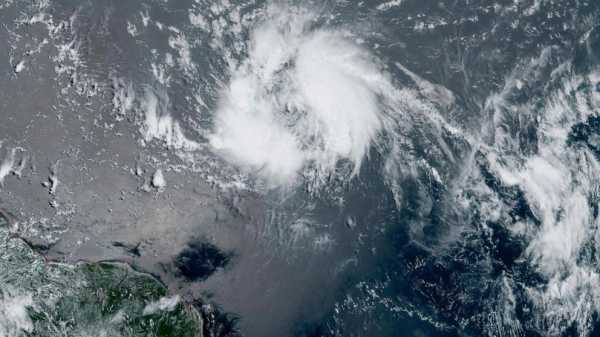
SAN JUAN, Puerto Rico — Tropical Storm Cindy has formed behind Tropical Storm Bret, in the first case of two storms in the tropical Atlantic in June since record keeping began in 1851, forecasters said Friday.
The historic event signals an early and aggressive start to the Atlantic hurricane season that began on June 1 and that usually peaks from mid-August to mid-October. Some forecasters blamed unusually high sea temperatures for the rare development.
“The Atlantic is awfully warm this year,” said Kerry Emanuel, a meteorologist at the Massachusetts Institute of Technology, adding that it's partly a result of global warming, natural variability and the ocean's recovering from sulfate aerosols pollution that cooled it decades ago.
Studies show that a warmer world is producing wetter and more intense hurricanes, with scientists still trying to figure out if climate change alters how many storms brew. Because of more early and pre-season storms, the National Hurricane Center has started issuing advisories earlier in the year, with experts recently discussing the idea of declaring the start of the hurricane season earlier.
Emanuel noted that in the entire Atlantic Ocean, not just the tropical Atlantic, it's not unusual to have storms in June. It has happened 34 times — including this year — since 1851, he said.
Cindy is expected to remain a tropical storm as it heads northeast into open waters.
Meanwhile, Bret brought winds, heavy rain and swells of up to 15 feet (4.5 meters) early Friday to islands in the eastern Caribbean that shut down to prepare for potential landslides and flooding. Officials in the French Caribbean island of Martinique said they found four people who were aboard a lifeboat after their catamaran sank during the storm, and that they were hospitalized.
Power outages were reported in St. Lucia and St. Vincent and the Grenadines, with at least 130 people seeking protection in government shelters as the storm washed away one home and caused severe damage to several others, according to officials.
Ralph Gonsalves, prime minister for St. Vincent and the Grenadines, told NBC Radio, a local station, on Friday that officials are still assessing the damage and are helping those in need.
“We will respond, as always, with speed,” he said.
Authorities in Barbados said they received more than a dozen reports of damage across the island, according to the Caribbean Disaster Emergency Management Agency.
The storm's center was west of St. Vincent and moving west into open waters at 18 mph (30 kph). Its maximum sustained winds were 50 mph (85 kph).
Airports, businesses, schools and offices closed on St. Vincent, St. Lucia, Dominica, Martinique and other islands by midday Thursday.
Gonsalves had urged people to go to shelters if they believed their home might not withstand the strong winds and heavy rains. “These storms can turn around fairly quickly,” he said.
Forecasters had warned that the storm might pass directly over St. Lucia, which is north of St. Vincent, but its path shifted south. Authorities in St. Lucia opened one shelter at the request of some residents who feared their homes would not withstand the storm.
Rainfall of 3 to 6 inches (8 to 15 centimeters) was forecast from the French island of Guadeloupe south to St. Vincent and the Grenadines, including Barbados, the U.S. National Hurricane Center in Miami said. Dangerous surf was also a possibility, the center warned.
Bret was expected to lose strength after entering the eastern Caribbean Sea and was forecast to dissipate by the weekend.
Meanwhile, Cindy's maximum sustained winds were around 50 mph (85 kph) on Friday, and forecasts called for some strengthening.
The National Oceanic and Atmospheric Administration has forecast 12 to 17 named storms for this year’s hurricane season. It said between five and nine of those storms could become hurricanes, including up to four major hurricanes of Category 3 or higher.
Sourse: abcnews.go.com






